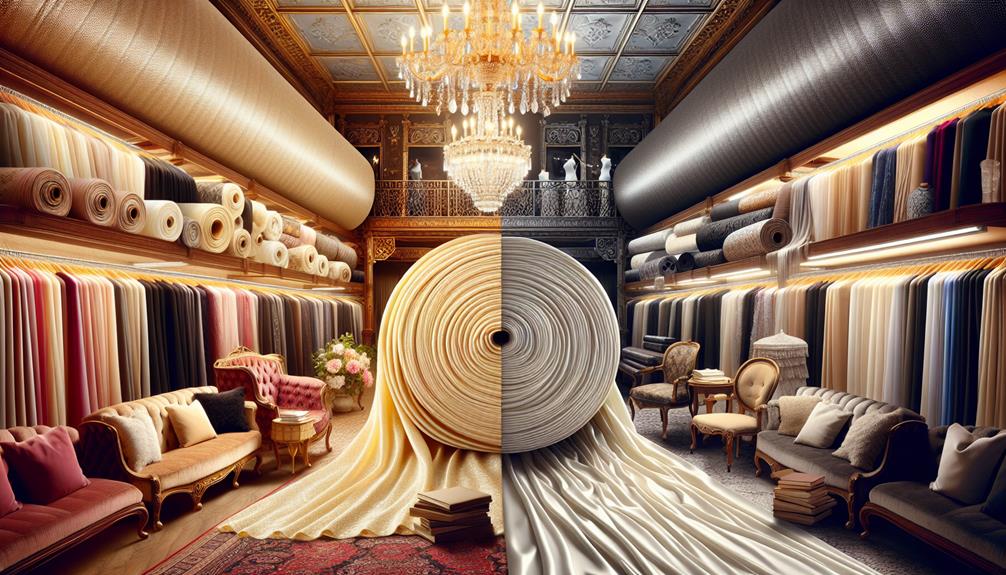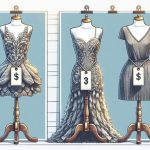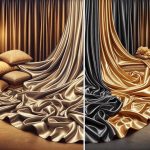I've often wondered if chiffon is a cheap fabric, considering its popularity. Well, it turns out the answer isn't straightforward. Chiffon can be made from various materials like silk, polyester, or cotton. Silk chiffon is definitely on the pricier side, offering a luxurious feel that justifies its cost. On the other hand, polyester chiffon is much more wallet-friendly and still maintains good quality. So, based on what it's made from, chiffon's price can really vary. There's a lot more to know about how these options differ, especially if you're considering which type might be the best for your needs.
Table of Contents
Key Takeaways
- Chiffon varies in price based on the material used, with silk being the most expensive.
- Polyester chiffon is the most affordable and widely used variation.
- Costs are influenced by raw materials, production complexity, and labor.
- Cotton and rayon chiffon offer mid-range pricing options.
- Market demand and supply dynamics also affect the overall cost of chiffon.
Understanding Chiffon Fabric
Chiffon is a lightweight, sheer fabric often used in elegant clothing like evening dresses and scarves. It's got a bit of a magical vibe, really, because it flows so beautifully. The fabric's lightness makes it perfect for those floaty, dreamy looks. But don't let its delicate appearance fool you; handling chiffon can actually be quite tricky because of its slippery nature.
When I'm working with chiffon, I've got to be extra careful. It frays easily, so I always use a sharp pair of scissors and work slowly to ensure clean cuts. Also, sewing with chiffon? It's a task. I often use French seams to hide the frays and give the garment a neat finish. This type of seam encases the edge of the fabric within another fold of fabric, which really helps in preventing those annoying frays.
Another thing to note is that chiffon isn't just about looks; it's also about feel. The fabric should feel cool and smooth against the skin, making it ideal for summer wear or layered styles in cooler weather. Understanding these details not only helps me in selecting the right fabric for my projects but also in achieving the best results in the finished product.
Types of Chiffon Materials
Now let's explore the different types of chiffon materials available. You might think chiffon's just chiffon, right? Well, not exactly. There's quite a variety, each with its own feel and use.
First up, there's silk chiffon. This type is the crème de la crème of chiffons. It's super soft, with a slight shimmer. Because it's made from natural silk fibers, it drapes beautifully but is also the most delicate. It's perfect for those fancy dresses.
Then we've got polyester chiffon. It's more common and way cheaper than silk. It's sturdy, holds dye well, and is easier to work with, making it a go-to for everyday wear and lots of bridal gowns. It doesn't feel as luxurious as silk, but it's practical.
There's also cotton chiffon, a rarer find. It combines cotton's comfort with chiffon's lightness. It's breathable and softer than polyester, yet not as flowy as silk. A good choice for casual blouses.
Each type has its pros and cons, so think about what you need your fabric to do before you choose. Whether it's for an elegant gown or a simple scarf, there's a chiffon that fits the bill.
Chiffon Production Process
Let's talk about how chiffon is made.
First, we need to look at the different fibers used, which can really affect the texture and durability.
Then, we'll get into how it's woven and finished, and how these steps influence the quality and cost.
Chiffon Fiber Types
Diving into how chiffon is made, it starts with choosing from a variety of fibers, including silk, polyester, or nylon. Each material offers unique attributes, influencing both the feel and the price of the final fabric. Here's a quick rundown:
- Silk Chiffon: It's the most luxurious option. Silk gives a super soft feel and a beautiful, natural sheen. It drapes like a dream but it's also the priciest.
- Polyester Chiffon: More affordable and very durable. It's got a slightly heavier drape than silk and resists wrinkles better. Great for everyday wear.
- Nylon Chiffon: Similar to polyester but even stronger and lighter. It's excellent for sheer layers in garments.
Weaving and Finishing Techniques
After selecting the right fiber, the chiffon's next step involves intricate weaving and careful finishing techniques. Let's break it down, shall we? The weaving of chiffon uses a plain weave technique but with a slight twist. The threads are alternately twisted which creates slight puckers. These puckers give chiffon its slight stretch and unique texture.
Here's how it's typically done:
| Step | Description | Importance |
|---|---|---|
| Twisting | Fibers are twisted before weaving | Adds strength and texture |
| Weaving | Plain weave with high twist yarns | Forms the basic fabric structure |
| Dyeing | Fabric is dyed to desired color | Provides aesthetics |
| Finishing | Setting finishes and treatments | Enhances durability and feel |
These steps are crucial for creating high-quality chiffon that's not only beautiful but also durable. Each phase must be carefully controlled to ensure the fabric meets the standards.
Quality and Cost Factors
Now that we understand how chiffon is made, let's examine how quality and cost are influenced throughout the production process. Here's what you need to know:
- Material Choice: The type of fiber used—silk, polyester, or a blend—affects both the texture and the price. Silk chiffon is pricier due to its natural origin and luxurious feel.
- Weaving Complexity: Chiffon's sheer nature requires a tight weave. More intricate weaves raise production costs but also enhance durability and feel.
- Finishing Touches: Chemical treatments for dyeing and achieving wrinkle resistance can vary in quality. Higher-end finishes boost both the cost and the appeal of the final fabric.
Each step matters, from choosing materials to final finishes!
Cost Analysis of Chiffon
Let's look at what goes into the cost of chiffon.
We'll cover the different types of chiffon, what it costs to make them, and the factors that set their market prices.
Understanding these can help us figure out if chiffon is really a budget-friendly option or not.
Chiffon Fabric Types
Diving into the cost analysis of chiffon, it's clear that the price varies widely depending on the type used. Here's a quick rundown:
- Silk Chiffon: This is the top-tier stuff. It's luxurious and feels amazing, but yeah, it'll cost you more. Silk chiffon is all about elegance and smooth texture.
- Polyester Chiffon: More budget-friendly for sure. It's durable and doesn't wrinkle like silk. Great for everyday wear without breaking the bank.
- Rayon Chiffon: Sits in the middle. Not as pricey as silk, but softer and nicer than polyester. It offers a good balance between cost and comfort.
Each type has its perks, so consider what you need before buying!
Production Costs
Understanding the production costs of chiffon is key to grasping why its price can vary so much. Let's dive in.
First off, the materials used matter a lot. Silk chiffon, made from natural fibers, costs more to produce than synthetic versions like polyester. It's not just about the raw materials, though.
The process counts too. Weaving chiffon is intricate, needing careful handling and specific machinery which ramps up production costs.
Labor isn't cheap either. Skilled workers are essential to produce high-quality chiffon, especially silk varieties.
Then there's scale. Smaller batches often mean higher costs per yard compared to mass production.
Market Price Factors
Building on how chiffon is made, let's now explore the various factors that influence its market price. Here are the top three:
- Materials Used: The type of fibers used in chiffon—silk, polyester, or a blend—significantly affects the price. Silk is pricier, while polyester is more budget-friendly.
- Production Complexity: Chiffon's delicate, sheer texture requires careful handling during production. This complexity can drive up costs, especially for high-quality silk chiffon.
- Supply and Demand: Like any other market, the dynamics of supply and demand play a huge role. Limited availability of high-quality silk and increased demand for chiffon during fashion seasons can hike up prices.
These factors make it clear that chiffon's price isn't just about the fabric itself—it's about the economics behind it.
Chiffon Vs Other Fabrics
Chiffon stacks up quite differently when compared to other fabrics like silk or cotton. Let's talk about how it really measures up. First off, chiffon's got this airy, lightweight feel that's hard to beat. It's made from twisted fibers, which can be silk or synthetic, giving it a slightly rough texture that's unique.
Now, if we dive into silk chiffon, it's all about luxury. It drapes beautifully and feels soft against the skin. But it's not just about looks; this fabric is seriously strong, despite its delicate appearance.
Cotton, on the other hand, is sturdier and more about comfort. It's breathable, sure, but it doesn't have that same flowy elegance that chiffon offers.
What's really cool about chiffon, especially the synthetic types, is its resilience. It holds up well in various weather conditions, unlike silk that can be a bit high-maintenance. Plus, synthetic chiffon is generally more resistant to wear and tear, making it a go-to for durability without the hefty price tag of silk.
Factors Affecting Chiffon Pricing
While we've explored how chiffon compares to other fabrics, let's now look at what influences its price. The cost isn't just about the tag you see; it's shaped by several key factors. Here's a breakdown:
- Material Source
Chiffon can be made from silk, cotton, or synthetic fibers like polyester. Silk chiffon is the priciest, given silk's high production costs and luxurious status. Synthetics, on the other hand, are cheaper and more abundant, which lowers their market price.
- Manufacturing Complexity
The process of making chiffon is intricate. Weaving lightweight and sheer fabric without compromising its quality requires precise techniques and equipment. This complexity can drive up the cost, especially for high-quality chiffon that maintains durability despite its delicate nature.
- Market Demand
Fashion trends hugely impact chiffon pricing. If there's a surge in demand, prices are likely to spike. Conversely, if it falls out of fashion, prices may decrease. Also, the geographical region and its economic status can affect demand and pricing. For instance, in areas where chiffon is a staple for traditional attire, prices might be more competitive.
Understanding these factors helps us grasp why chiffon might be priced differently in various contexts.
Frequently Asked Questions
How Do I Wash and Care for Chiffon Garments?
I usually hand wash my chiffon clothes in cold water with mild detergent and lay them flat to dry. It's gentle and keeps them looking their best. Definitely avoid wringing them out!
Can Chiffon Fabric Be Dyed Easily at Home?
I've found that dyeing chiffon at home can be tricky. It's important to use the right type of dye and follow specific steps to avoid damaging the fabric. Always test a small area first.
What Sewing Techniques Are Best for Chiffon?
I've found that using French seams or narrow rolled hems works best for chiffon. These techniques prevent fraying and give your project a clean finish, crucial for mastering sewing with this delicate fabric.
Is Recycled Chiffon Fabric Available in the Market?
Yes, recycled chiffon fabric is available in the market. I've seen it sold in several online stores that specialize in sustainable textiles. It's a great choice for eco-conscious fashion projects.
How Is Chiffon Typically Used in Fashion Design?
Chiffon's basically the ninja of fabrics in fashion design, sneaking into everything! It's used in blouses, dresses, and scarves, adding that light, airy touch that screams elegance without even trying too hard.
- Is Chiffon a Cheap Fabric? - April 23, 2024
- Is Chiffon Always Silk? - April 23, 2024
- Is Chiffon More Expensive Than Silk? - April 23, 2024







